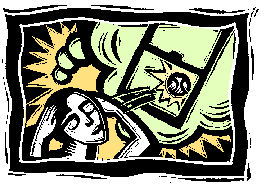

The power of human imagination may be stronger than previously suspected, blurring the line between memory and imagination. "One simple act of imagining a fictitious childhood event increased people's confidence that the event happened to them," says UW Psychology Professor Elizabeth Loftus.
In one recent Loftus study, subjects were given a written list of 40 possible childhood events and asked about the likelihood that these events happened to them.
Two weeks later, researchers told subjects to imagine some events they had earlier identified as not occurring, such as falling and breaking a window, getting in trouble for calling 911, finding a $10 bill in a parking lot or being pulled out of the water by a lifeguard. After imagining several situations, the subjects again rated the list of 40 childhood events.
Comparing the answers from the two lists, Loftus and her colleagues found that a one-minute act of imagination led a significant minority of subjects to say an event was more likely to have happened. These subjects had previously identifying the same events as "unlikely to have occurred." In the broken window scenario, 24 percent of the subjects who imagined the event showed a jump in their belief that the event had actually happened.
Loftus says there are several possible explanations for "imagination inflation." An act of imagination might remind some subjects of a true experience. Another and more likely explanation, she says, is that an act of imagination simply made an event more familiar when subjects made their second assessment.

One reason why many more women than men suffer from problems with their jaws--what doctors and dentists call temporomandibular disorders--may be related to the role of female reproductive hormones.
Researchers estimate that 10 million Americans suffer from jaw disorders. Facial pain from jaw problems is twice as common among women, especially those of childbearing age. While the cause is unknown, there are a range of theories about the condition and, likewise, a variety of treatment options, including techniques to reduce stress, medications to control pain and the use of mouthguards to protect teeth.
In January UW researchers reported a possible link between the use of hormone therapies and the incidence of jaw disorders among women. Dentistry Research Professor Linda LeResche studied a group of post-menopausal women who had been referred for jaw pain treatment and another group who were not referred for the disorder. "We found that women receiving hormone replacement therapy were 70 percent more likely than non-users to be suffering," says LeResche.
Additionally, researchers studied 1,400 women aged 15 to 35 with jaw problems and 5,600 without the condition. They found that women using oral contraceptives were 20 percent more likely to have jaw pain. "Further research is needed to clearly identify hormones as a possible cause," LeResche says. "Most likely they are only one of many causal factors."

Heart attack patients show nearly identical survival rates, whether treated with powerful anti-clotting drugs or with balloon angioplasty, say UW researchers in a recent issue of the New England Journal of Medicine.
Researchers compared the death rates, both during hospitalization and over the following three years, among 2,095 community hospital patients treated with drug therapy and 1,050 patients treated with primary angioplasty. In this procedure a probe is inserted into an artery and the tip inflates like a balloon to expand the walls of blood vessels. They found no difference in mortality, says Medicine Professor Nathan R. Every.
Earlier studies had showed patients treated with angioplasty had lower hospital mortality rates, says Every, but these earlier studies were done at medical centers that perform more primary angioplasties than the average community hospital.
The study also showed that medical costs, as well as the number of additional procedures, were lower among patients treated with drug therapy, in both the short and the long term. Hospital costs averaged $3,000 less among patients receiving drug therapy.
"Cardiologists have taken hold of primary angioplasty," says Every. "The argument is that it saves more lives. Our message is that the two therapies are equally effective."
Vistas is a quarterly column on recent research findings at the University of Washington complied by Columns Editor Tom Griffin.
Send a letter to the editor at columns@u.washington.edu.